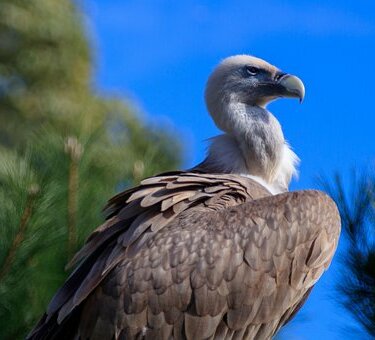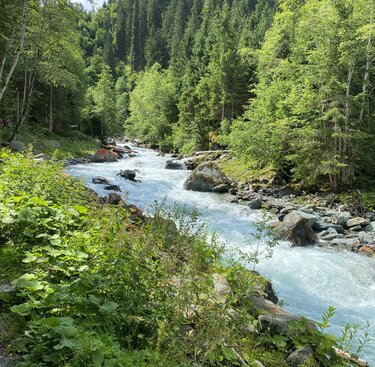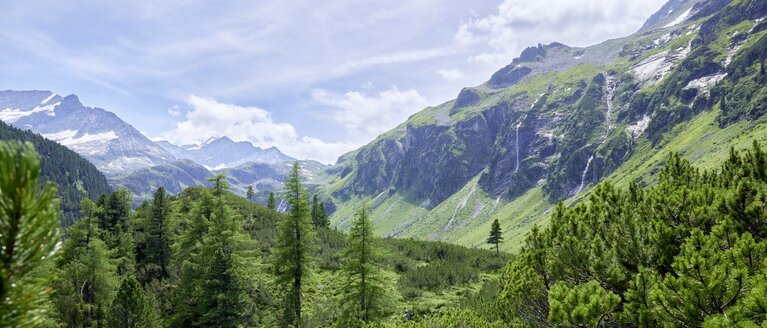Hollersbachtal
Hollersbach
Peaks and crossings
- Larmkogel (3.017 m)
- Kratzenberg (3.022 m)
- Seekopf (2.921 m)
- Abretter (2.979 m)
- Tauernkogel (2.988 m)
- Geieringhöhe (2.746 m)
- Hoher Herd (2.824 m)
- Pihapper (2.513 m)
- via Sandebentörl (2.751 m) to the Venedigerhaus /Innergschlöss
- via Larmkogelscharte (2.933 m) to the Neuen Thüringer Hütte
Valley of Vultures

Valley of Vultures
The griffon or white-headed vulture is a summer visitor to the national park. Up to 100 of these majestic griffins visit the area. The groups regularly seek out traditional roosts in the evening. Some are in the Krumltal (Rauris), others here in the Hollersbachtal. The vulture roosting walls are located in the Steigklamm gorge east of the Ofnerboden and further into the valley on the Geiering, a prominent rocky ridge. The sites can be recognised by the whitewashed patches of droppings. Nitrogen-loving red lichens are often found there.
Active alpine farming favours
The approx. 18 km long Tauern Valley is wider and more open than the neighbouring valleys. The wide valley floors and the geological subsoil (slate rock) favour active alpine pasture farming. In its heyday there were up to 34 alpine pastures in the Hollersbachtal, today the area of alpine pastures still covers about 3,500 ha. The timberline has been artificially lowered to about 1,700 metres, above which there are extensive dwarf shrub belts, alpine meadows and alpine grasslands.
The largest Mountain Lake in the National Park
Lake Kratzenberg (a natural monument since 1974) at 2,167 m above sea level is around 24 hectares in size and a maximum of 32 metres deep, making it the largest natural mountain lake in the Hohe Tauern National Park. Rock and extensive scree slopes line the shore. In the south there is a remarkably beautiful siltation area with Scheuchzer's cotton grass. Lake Ofnerboden (1,465 m) is also a unique habitat. It was formed by landslides from the Säullahngraben and the Steigklamm. Mighty boulders are witnesses to this geological fault zone. Here, weathering easily attacks and triggers mudslides and landslides, a major mudslide most recently in 1933. The Vordermoos and Hintermoos in the south-eastern end of the valley - the Weißenbachtal - are natural treasures. The stream meanders through the fens, interesting mire plants and endangered plant species grow here. These are very sensitive habitats - please do not enter!
Instructive - the Bachlehrweg

Instructive - the Bachlehrweg
The interesting nature trail leads through a beautiful Grauerlenau along the orographically right bank of the stream. Mosses, ferns and butterbur are common. In the adjacent spruce forest, blueberries can be found, winter goldcrest and fir tit live here. Yellow lichens grow on the damp rocks near the stream. The boards provide information on the biological and ecological relationships in and around the stream. In front of the Wirtsalm, old stone walls line the path and are worth a closer look. In about 20 minutes you reach the Senningbräualm (snack station) and from there after about 30 minutes the Edelweißhütte (1,219 m).
Walking time: approx. 30 minutes from Hollersbach to the car park, then approx. 1 hour to the Wirtsalm (1088 m).
Full of views - Neue Fürther Hütte and Lake Kratzenberg
The ascent to the left of the material cable car leads in serpentines to a large stone alpine meadow, where the view opens up into the enchanting Weißeneck valley with its meanders in the Vordermoos and Hintermoos. An ideal resting place to observe ibexes, chamois, bearded vultures and white-headed vultures. Even edelweiss can be found in this area. The Neue Fürtherhütte is still forty minutes away from this spot. The three-thousand-metre peaks are reflected in the nearby Kratzenbergsee. The local mountain, the Larmkogel can be reached in about 2 ½ hours from the hut.
Walking time: from the car park approx. 2 hours to Edelweißhütte, from there approx. 3 ½ hours to Fürther Hütte.
National Park Workshop in Hollersbach - Environmental Education with All Senses
In the Klausnerhaus – a rustic residential building from the 14th century – you can find the national park workshop. Here (not only) children will learn how to approach nature by means of various modules such as churning butter, gathering wild and healing plants, national park detectives and tracking as well as the history of our trees and forests. Factual information is presented in a pedagogic way and is slipped into the activities in passing.


